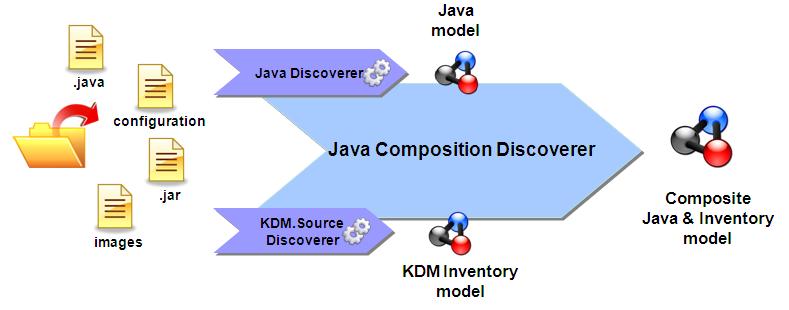Notice: this Wiki will be going read only early in 2024 and edits will no longer be possible. Please see: https://gitlab.eclipse.org/eclipsefdn/helpdesk/-/wikis/Wiki-shutdown-plan for the plan.
Difference between revisions of "MoDisco/Components/Java/Composition/Documentation/0.9"
(→User manual) |
(→User manual) |
||
| Line 34: | Line 34: | ||
[[Image:Javakdmdiscoverypopup.JPG|frame|center|Discovering a JavaApplication model]] | [[Image:Javakdmdiscoverypopup.JPG|frame|center|Discovering a JavaApplication model]] | ||
| + | The [http://wiki.eclipse.org/MoDisco/Components/Java/Documentation/0.9#User_manual Java discovery parameters window] appears for customizing the Java Model Discovery step. | ||
| + | |||
| + | Once launched, a progress bar will appear at the bottom of the window as soon as the operation begins. Depending on the size of your application, the reverse engineering process might take some time to complete (see next Figure). | ||
| + | |||
| + | [[Image:MoDisco-JavaDiscoverer progress bar model creation.png|frame|center|Progress bar during model creation]] | ||
| + | |||
| + | At the end of the process, the newly created model files are added to the root of your project and the main file is automatically opened in the default editor. | ||
| + | A xmi file suffixed by ''_javaapp.xmi'' contains the root element of the model, which refers to the ''.javaxmi'' Java model file and the ''_source.kdm'' Inventory model file. | ||
| + | Some referenced xmi ''fragment'' files are serialized into a ''xmiFragmentsJavaApp' directory (see Resources view in benchmark). | ||
| + | |||
| + | [[Image:TODO.png|frame|center|JavaApplication xmi files in the package explorer]] | ||
=== Discoverer API === | === Discoverer API === | ||
Revision as of 14:20, 19 August 2010
DEPRECATED use Template:MoDiscoTabs and Template:MoDiscoTab as explain here : Wiki Template for MoDisco
Contents
Java Composition Metamodel
Description
This metamodel JavaApplication aims at weaving a MoDisco Java Model with a MoDisco KDM Inventory Model. It relies on the core metamodel described in the kdm.source extension framework.
Such a metamodel allows to link java nodes to their physical position in the source files (JavaNodeSourceRegion metaclass owning startLine endLine properties).
As proposed in kdm.source extension framework, the reference JavaASTNodeSourceRegion.javaNode derived from ASTNodeSourceRegion.node. So as the Java2File.javaUnit from CodeUnit2File.unit.
Note : the references java2DirectoryChildren and java2FileChildren are expected to be containment references. For some technical reasons (memory usage tuning via lazy loading), they are not containment to make sure that the Java2Directory, Java2File and JavaNodeSourceRegion instances are managed in their own graph compared with JavaApplication instances (See benchmark).
Java Composition Discoverer
Description
MoDisco provides a discoverer associated to the metamodel definition described here. The discovery takes as an entry one workspace Java project. The first step of the discovery creates one Java and one Kdm inventory model, using the associated discoverers. The second step creates a model with JavaApplication metamodel instances with references to the two models.
User manual
The plug-in provides the user with a contextual menu to easily create models.
By right-clicking on a Java Project in the Eclipse Package Explorer view, you can quickly create the Java Application model of your application (see next Figure).
The Java discovery parameters window appears for customizing the Java Model Discovery step.
Once launched, a progress bar will appear at the bottom of the window as soon as the operation begins. Depending on the size of your application, the reverse engineering process might take some time to complete (see next Figure).
At the end of the process, the newly created model files are added to the root of your project and the main file is automatically opened in the default editor. A xmi file suffixed by _javaapp.xmi contains the root element of the model, which refers to the .javaxmi Java model file and the _source.kdm Inventory model file. Some referenced xmi fragment files are serialized into a xmiFragmentsJavaApp' directory (see Resources view in benchmark).
Discoverer API
Each MoDisco discoverer responds to a normalized interface and can be called programmatically (see org.eclipse.gmt.modisco.infra.discoverymanager.Discoverer).
As an example, you may checkout the code from org.eclipse.gmt.modisco.java.composition.discoverer.tests project.
Requirements
To use the plug-ins you need:
- JDK 1.5 or above
- a version of Eclipse 3.6 or above with the following set of plug-ins installed
- EMF 2.5.0 or higher
Source Repository
All of the source code is stored in a public source repository, which you can access at:




